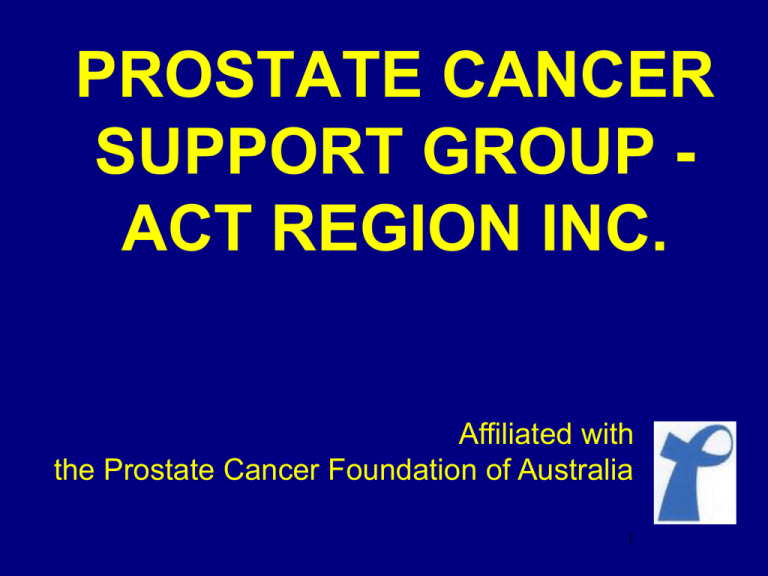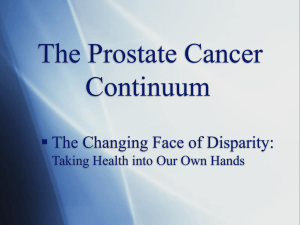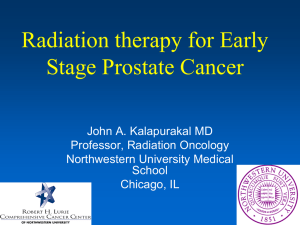
PROSTATE CANCER
SUPPORT GROUP ACT REGION INC.
Affiliated with
the Prostate Cancer Foundation of Australia
1
Who we are
• A friendly group of prostate cancer
survivors and their partners
• We are NOT medical professionals but
can provide information and express
opinions based on our personal
experiences
• Your GP is your first source of advice,
and then an experienced, successful
urologist
2
The Prostate
• Small gland - size of walnut
• Produces fluid that nourishes and
protects the sperm
• Located beneath the bladder
• Surrounds the urethra in the shape
of a doughnut
3
Bladder
Rectum
Seminal vesicle
Pubic bone
Prostate
Urethra
Penis
Testis
4
4
Symptoms of prostate disease
•
•
•
•
•
•
•
difficulty starting urination
slow flow
urination frequency
urgent need to urinate
nocturia – need to urinate during night
difficulty emptying the bladder
Leaking
Note: sometimes there are no
symptoms of disease
5
Main prostate disease conditions - 1
Benign Prostatic Hyperplasia (BPH) or
Benign Prostate Enlargement (BPE):
• non-cancerous condition
• enlarged prostate
• difficulties with: starting, flow, frequency,
urgency, nocturia, etc
• Treatment options: lifestyle, medication,
surgery (e.g. TURP – “rebore”)
6
BPH
7
Main prostate disease conditions - 2
Prostatitis:
•non-cancerous condition
•prostate infection or inflammation
•symptoms can include: urination difficulty,
frequency, painful urination or ejaculation,
flu-type symptoms (fever, chills, aches),
back, pelvic or groin pain
•treat with medication
8
Main prostate disease conditions – 3
Prostate cancer:
•malignant
•tumor/s
•develops in prostate gland
•may spread to other parts of the body
9
Prostate cancer Statistics - 1
• Most commonly diagnosed cancer for men
excluding non-melanoma skin cancers
• About 20,000 new cases diagnosed each
year
• Men have 1 in 8 chance of being
diagnosed with prostate cancer before age
75
Note: women’s risk of breast cancer: 1
in 11
10
10
Prostate cancer Statistics – 2
• 2nd most common cause of cancer deaths
in men (after lung cancer)
• About 3,300 deaths each year (more than
breast cancer deaths amongst women)
• Early detection can save lives
11
(Males and females combined)
19,403
14,234
12,670
10,342
9,703
7,276
3,091
2,897
2,580
2,525
12
(Males and females combined)
7,626
4,047
2,938
2,706
2,552
2,344
2,248
1,459
1,279
1,129
13
Symptoms of early
prostate cancer
14
Major risk factors
•
•
•
Gender - only men have a prostate
•
Family history of multiple cases of breast or
ovarian cancer
•
•
•
Life style - diet, exercise, smoking, etc
Age
First-degree relatives (father, brother, son)
with prostate cancer – two-fold or greater risk
Ethnicity – e.g. Afro-Americans
Some special groups – e.g. Vietnam
veterans; regional and rural men
15
Reducing risk
• Lifestyle – exercise, diet, etc.
• Don’t smoke
• “What’s good for your heart is
good for your prostate”
16
Resolving the possibility
of prostate cancer
• First step: talk to your GP
• Initial tests usually:
PSA (Prostate Specific Antigen)
blood test
DRE (Digital Rectal Examination)
17
Testing policies - 1
•
Prostate Cancer Foundation of
Australia:
should be included in evaluating initial
urinary symptoms
annual testing from age 40 if family
history of prostate cancer
annual testing as part of general
checkup from age 50 for other men
Combination of PSA and DRE usually
recommended
18
Testing policies - 2
•
Urological Society of Aust. and NZ:
Initial PSA and DRE at age 40 for all
men, then:
High risk cases tested regularly; lower
risk cases tested less frequently
19
PSA test
PSA test measures the level of Prostate
Specific Antigen in your blood:
•
•
requires small amount of blood for analysis
•
•
•
single test may not be reliable
elevated level may indicate prostate cancer or
other prostate disease
if single elevated result : retest
rate of change over time provides more reliable
information
20
PSA levels and age
PSA level increases with age:
• level of PSA should be compared with
normal level for your age
• high PSA for your age could be due to
conditions other than prostate cancer
21
PSA levels by age group
(illustrative statistics only)
AGE
AVERAGE
SERUM PSA
(ng/ml)
40-49
50-59
60-69
70-79
0.65
0.85
1.39
1.65
UPPER LIMIT
OF NORMAL
SERUM PSA
(ng/ml)
2.0
3.0
4.0
5.5
Source: www.andrologyaustralia.org
22
DRE (Digital Rectal Examination)
DRE can be undertaken by your GP. Involves
insertion of gloved finger into the rectum to feel
prostate for any abnormality (tenderness,
enlargement, hardness, growths)
Image copyright 2000 by
Nucleus Communications,
Inc. All rights reserved.
http://www.nucleusinc.com
23
Next step in diagnosis consult a urologist - 1
24
Consult a urologist - 2
•
If level of PSA and/or DRE results are of
concern, the usual next step would be referral
to a urologist
•
In consultation with your GP choose an
experienced, successful urologist
•
Urologist may recommend biopsy:
small samples of prostate tissue extracted
from the prostate
pathologist looks for cancer cells in the
samples
25
Biopsy results
• Biopsy is only based on a sample of cells
• If no cancer cells detected:
does not guarantee that there is no
cancer
further monitoring through PSA and
DRE and further biopsies may be
appropriate
26
Gleason score
•
Pathologist grades any prostate cancer cells
found using a scale ranging from 1 to 5
•
“Gleason score” calculated by adding the values
for the two most common grades of cells
•
“Grade” is determined from Gleason score:
2 to 4: very slow growing
5 to 6: slightly faster growing
7: becoming more aggressive
8: aggressive
27
Other tests
Depending on PSA history, DRE and biopsy
results, the urologist may propose other tests to
determine the progression of the cancer:
• Whole body bone scan (to detect spread)
• CT scan
• MRI scan
• PET scan
28
Treatment options - 1
Active surveillance or watchful
waiting:
•
•
•
frequent follow-up PSA tests
possibly periodic biopsies
change to other treatment if
changes indicate it is warranted
29
Treatment options - 2
Surgery:
•
•
•
Open radical prostatectomy
Laparoscopic radical prostatectomy
Robotic laparoscopic radical
prostatectomy
30
Treatment options - 3
Radiotherapy:
• External beam radiotherapy (EBRT)
• Brachytherapy:
low dose rate seed brachytherapy
or
temporary high dose rate
brachytherapy (followed by
EBRT)
31
Treatment options - 4
Hormone therapy - androgen
deprivation therapy (ADT). May be
used:
• in conjunction with radiation
therapy or
• after recurrence of prostate
cancer
• for advanced prostate cancer
32
Treatment options - 5
Treatments that may have potential:
•
•
•
Chemotherapy and immunotherapy
cryotherapy (freezing) - experimental
HIFU (High Intensity Focused
Ultrasound) - experimental
33
Deciding on treatment - 1
Factors to be taken into account:
•
•
•
•
•
risk factors (family history, etc)
age and life expectancy
overall health
“grade” (Gleason score)
“stage”:
localised (T1 or T2)
locally advanced (T3 or T4)
advanced or metastatic (N+ or M+)
34
Deciding on treatment - 2
Become informed:
• publications and audiovisual
material (e.g. see stuff on our web
site)
• talk to other cancer survivors:
discuss with one of our
members on a confidential basis
come to a monthly meeting
35
Deciding on treatment - 3
•
If possible, get more than one
opinion on treatment options
•
Evaluate risks and benefits of
treatment Vs active surveillance
•
Evaluate side effects for each
treatment option
• Life expectancy considerations
• Discuss with partner and family
36
Possible side effects of
treatment - 1
• Surgery:
urinary incontinence (often only short term and
treatable), erectile dysfunction (can be long
term and harder to treat)
• Radiotherapy:
irritation of urinary tract and/or bowel, other
urinary problems, erectile dysfunction, nausea,
skin reactions, lethargy
• Hormone therapy:
loss of libido, lethargy, energy loss, hot flushes,
mood swings, weight gain, bone strength loss
37
Possible side effects of
treatment - 2
Side effects and recovery can vary from
patient to patient depending on:
•
•
•
•
•
•
•
•
Skills of specialists involved
Grade and Stage of the cancer
Training before and after treatment (e.g
pelvic floor exercises)
Rehabilitation effort
Age
Health
Lifestyle (e.g. diet, exercise)
Attitude
38
The good news
•
Usually, prostate cancer is slow growing and
after treatment, survival rates are high and
improving.
•
If the cancer is localised to the prostate gland,
then chances of enduring remission with
minimal or manageable side effects are very
good.
•
If the cancer has advanced beyond the
prostate gland its progress can usually be
managed, enabling an enjoyable and useful
life for many years.
39
Moral of the story - 1
•
Prostate cancer is the most
common male cancer in Australia
excluding non-melanoma skin
cancers
• Prostate cancer can develop
without any noticeable symptoms
• Early detection is of critical
importance and facilitates effective
treatment options
40
Early Detection
“I’d have been here sooner if it hadn’t
been for early detection”
41
Moral of the story - 2
• Talk to your GP and implement a suitable
PSA and DRE testing regime from age 40
• If PSA or DRE or biopsy are of concern,
get informed so that you can make a good
decision about what treatment or
management option is best for you.
• Ensure that you are being advised by
experienced and successful specialist/s
42
Moral of the story - 3
•
PRIOR to agreeing to a treatment strategy:
inform yourself - see:
prostate-cancer-support-act.net and
www.prostate.org.au
talk to members of our support group
Attend sessions run by ACT Health’s
continence nurses (pre- and post-treatment)
discuss with partner and family
• Maintain a positive attitude - there can be a
satisfactory outcome in the longer term
43
Prostate Cancer Support
Group - ACT Region Inc.
•
Phone: contact President or Secretary – details
on web site
•
Monthly electronic newsletter The Walnut – free
– details on web site
•
Our web site:
prostate-cancer-support-act.net
•
Affiliated with Prostate cancer Foundation of
Australia
44
Prostate Cancer Foundation
of Australia (PCFA)
•
Helping men and their families through
national network of prostate cancer
support groups
•
•
Funding research into prostate cancer
•
•
Raising awareness about prostate cancer
•
Free-call help line: 1800 220 099
Fostering consumer participation in
cancer research
Web site: www.prostate.org.au
45





